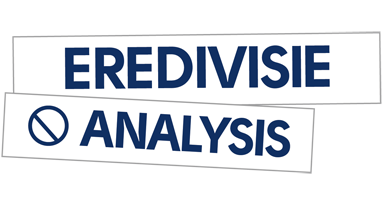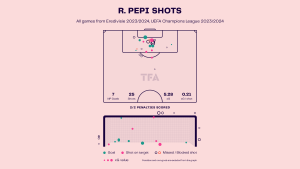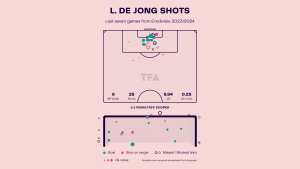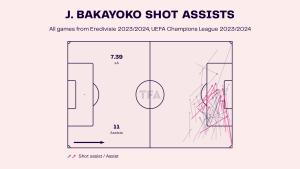Ajax will not be the only Eredivisie side confident of a successful league season in 2020/21 – after the curtailing of the 19/20 campaign resulting in no winner being crowned, clubs like AZ Alkmaar and Feyenoord will expect themselves to be right in the mix this time around. The summer of 2020 has been a busy one for Ajax: losing two of their biggest stars in Hakim Ziyech and Donny van de Beek, who joined Chelsea and Manchester United respectively. With some new signings and the continued development of their own academy products, Ajax are seemingly prepared for the season. They enjoyed a successful run of pre-season fixtures, picking up wins against tough opposition, avoiding defeat all the way through.
This tactical analysis report will provide an Ajax 2020/21 preview of sorts, discussing topics such as key tactical elements from last season that we will likely see this season, along with an analysis of new system elements they may introduce. There will also be a discussion about the club’s transfer activities and how the new recruits could have an impact on the club.
2019/20 in review
In this section will examine the numbers behind Ajax’s performance in the Eredivisie last season as we look to pinpoint their more successful facets of the game while uncovering any potential areas for concern. Furthermore, we will also take a look at some of the key components of their tactical approach from the 19/20 season – ones that will likely be deployed for the forthcoming campaign.
With a total of 68 goals in the league, they were the division’s top scorers by some way, and let in 23 goals – the second-best defensive record behind Alkmaar. This sort of record is a result of their attacking approach, and how they look to dominate the ball throughout the season, game-to-game. This is demonstrated through their ability to overpower the opposition and keep a lot of possession in 19/20, recording an average of 62% possession per game. They often achieve this by playing with a high and wide shape, and committing a lot of players forward for the patient attack, as seen in the image below.

As we can see, Ajax have eight players forward in this example (including the man on the ball). The positioning of those eight, however, is not random. They have three attacking players towards the back-post-side of the box, occupying the defenders and being ready for delivery should one arrive. The next three, formed in the triangle, are there to offer an approach that differs from simply crossing it. Their job is to provide close support to Tagliafico, and with a high number of opponents busy marking a player/zone, these three Ajax players have a lot of room to work in. The final option for Tagliafico is the wide option. Ajax have displayed strengths in attacking the flanks for some time now, especially when there is a lot of space ahead to run into, as is the case in this and many other scenarios.
The next tactical element builds on from the last point made about attacking the flanks. The wide and often inverted forwards for the Dutch giants play huge roles in the Ajax set up, and if their pre-season performances are anything to go by, the importance of their roles has not been downgraded or altered.

Above, we see Ajax looking to break during a transition, something they are very efficient and dangerous in. Upon retrieving the ball, the two Ajax winger immediately make themselves available without an opponent close to either of them. This causes panic and uncertainty for the three central defenders who have to act quickly and decide whether to remain as a compact unit or separate and mark one of the wide men to force Ajax down one side. However, Ajax’s runs off the ball elsewhere and their ability to react quickly in situations like this make them very hard to stop. This example was actually taken from a recent friendly, but this method of attack is nothing new for Ajax.
Off the ball, Ajax were very focused and well-drilled in their responsibilities. Instead of dropping off and allowing the opposition to push higher up and attempt an attack, Ajax often deploy a counterpressing style, looking to either force an error from the opponent, or majorly slow their attack down.

Above we have a typical example of how you would see Ajax shaping up off the ball. The opposition right-back was closed down quickly, meaning he had no option to turn back to his own goal and pass to his goalkeeper – who then cleared the ball out for an Ajax throw in. Every Ajax player in the image above plays an important role. The positioning of the two highest attackers allows them to mark the close opposition defender as well as lurk at a distance from the goalkeeper, ready to pounce and apply pressure if the pass to him is made. The shape of the midfield unit does a similar job – allowing them to block any potential passing options as well as occupying potentially dangerous space. With Ajax not making any major shifts in their tactical approach this season, it is highly likely that we will see more of this from Erik ten Hag’s men during 2020/21.
Summer 2020 Transfers
A number of players departed Amsterdam during the summer, with Ajax raking in a total of £72m. As mentioned, key players Ziyech and van de Beek have left the club, but they aren’t the only players of importance who we won’t be seeing in an Ajax shirt anytime soon. A surprising one is that Joel Veltman will no longer be around after securing a move to Premier League outfit, Brighton. The versatile defender, who has well-rounded qualities, featured on 19 occasions in the league last season and was a reliable option at the back. Ten Hag must feel that he has sufficient numbers at right-back with Sergiño Dest and Noussair Mazraoui. The club also waved goodbye (again) to veteran Ryan Babel following the expiration of his loan deal. While it is uncertain whether or not Ajax are keen to bring the attacker back, he played an important role in last season’s performance – another player with versatility in his game.
Despite all this, they’ve recruited three players so far, as well as the emergence of young stars such as Ryan Gravenberch, who could have a bit part to play this season. They’ve added experience to the goalkeeping ranks and by extension, the dressing room, with the arrival of Maarten Stekelenburg. The 37-year-old returns after nine years away, with spells in Serie A, Ligue 1 and the Premier League. He will act as understudy to Andre Onana – a reliable backup keeper indeed. Two new signings who will hope to have more of an impact in the first eleven are Antony and Mohammed Kudus, two young attack minded players. Antony, the club’s record signing, is a 20-year-old winger who possesses great creativity and attacking based attributes, who has so far displayed impressive potential. Kudus, a 19-year-old central attacking midfielder, arrives for a slightly lower fee than Antony. His performances in the top tier of Norwegian football attracted interest from several clubs around Europe, but he sees Ajax as the best place for his development. He also brings versatility – thanks to his impressive physical attributes, he could quite comfortably play a deeper role in the Ajax engine room.
Introducing Fresh Tactical Elements
While it has been mentioned that there will be no wholesale changes to the way Ajax conduct themselves from game-to-game, manager ten Hag was quoted in saying that some slight alterations will be made following the departure of Hakim Ziyech. Ziyech’s playstyle was a somewhat unique one, meaning Ajax could centre part of their tactical philosophy around him and his abilities. The players they have brought in may not be currently at the level of Ziyech, and it is uncertain that they will ever reach those heights – but their playstyles differ to Ziyech’s, thus resulting in slight changes to their approach.
One new attacking method which has surfaced in Ajax’s play during pre-season is the use of inverted full-backs. In recent times, we have become accustomed to seeing Ajax play with a high and wide shape, which saw the full-backs in very wide attacking positions, sometimes offering overlap runs behind the wingers. However, as we can see in an example below, they are exploring alternative ways of progressing an attack to broaden their arsenal.

Again, we see Ajax pushing forward with a high a wide shape, giving themselves plenty of room as the opposition are defending fairly narrow. In this example, left-back Tagliafico is carrying the ball in a much narrower position than we are used to seeing him in. There have also been examples of both full-backs making underlapping runs in similar areas to this one to support the attack. Playing in a more central area like this gives Ajax the opportunity to overload to the middle, increasing their chances of either penetrating the opposition defence, or finding a winger out wide with a lot of space to carry the ball into.
While we shouldn’t expect to see this approach every single time Ajax go forward, the way they executed this move on a number of occasions suggests that is a tool they have been working on in training and could be something they incorporate into certain games – it could also serve as a “plan B” if they struggle in progressing the attacks in their usual way.
Another interesting method they have been exploring (again) centres around young midfielder Ryan Gravenberch, and it relates to the role that used to be occupied by Frenkie de Jong.

Above is an example of Gravenberch dropping deeper alongside the two Ajax centre backs as they look to beat the initial press from the opposition. Having three players like this alongside each other makes it easier for Ajax to play out from the back and build an attack. Although this system was as present last season, this is not completely new. Back when Frenkie de Jong was still an Ajax player, he would often play a similar role to Gravenberch, dropping in to play as a makeshift centre back in possession, helping Ajax even more with the high and wide philosophy.
It is clear that Gravenberch possesses the abilities to play this role, as well as undertake various other midfield duties, and playing this way against certain systems may give Ajax more fluidity and success in moving the ball into wide areas to then build the final phase of the attack.
Conclusion
Despite losing some key and arguably world class talent, Ajax have recruited smartly and quickly to ensure their preparation for the new season wasn’t halted. An impressive series of wins during pre-season has set them up nicely for a strong start to the Eredivisie when they travel to Sparta Rotterdam. Throughout the season, we would expect Ajax to play with confidence, dominating possession in most games. Attacking frequently with a high number of players in the final two thirds will likely be a staple of their philosophy, with other smaller details like underlapping full-backs and dangerous wingers being vital to sustaining a winning mentality.









